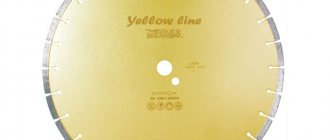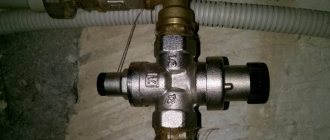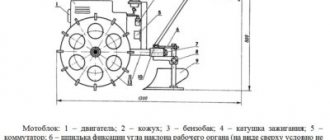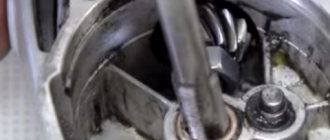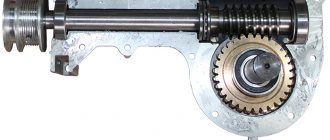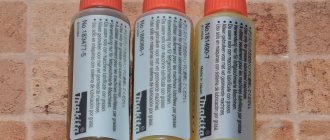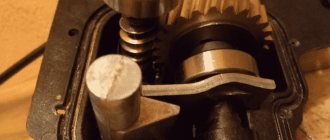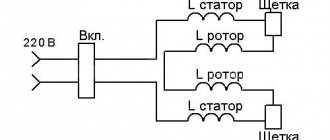Bosch GWS 1000 grinder in use. Photo VseInstruments.ru
In this article we consider the issue of lubrication of angle grinders in detail and from different angles. If you are looking for where to buy lubricant, whether to do it yourself, how to lubricate, or where to find a service center for maintenance, then please follow the links.
About the essence of the problem
The pioneers of the operation of the first angle grinders, which began to arrive in the USSR from the Bulgarian People's Republic in the 70s of the twentieth century, will willingly talk about their meetings with the grinder. “It was a good car, good for everyone. But it’s just very brittle.” Yes, that's a fact. A grinder, obtained by a piecework worker, for example, a steel casting cutter, worked in three shifts under maximum loads and rarely lived to see a year. The reason for failure, or even emergency breakdown of scarce grinders, was one common reason - wear of the gearbox with destruction of the gears. Repairmen of those years recall: “You take it apart, the engine is like new, the bearings are all right, the brushes are intact, and the gearbox is finished...”
The operating instructions for the first grinders said in pure Russian: “carry out regular maintenance using recommended materials for lubricating bearings and gears, see list.”
The trouble was that “recommended materials” were even more in short supply than the sander itself.
Lubricant for the gearbox of popular brands of trimmers
Rice.
Types of gear lubricants Well-known companies produce their own lubricants:
- For gearboxes, the lawn mower recommends using Stihl Superlub FS gear lubricant, available in tubes from 250 g to 80 with a special pointed tip for ease of application, has a silver-orange color;
- The manufacturer recommends that the gearboxes of Patriot lawn mowers be serviced with a self-produced lubricant based on lithium components called Arsenal AR-417;
- The Huter company offers Rezoil and CIATIM plastic universal lubricants for its products; all of the above lubricants can also be used;
- In all cases, it is necessary to monitor the condition of the gear unit, lubricating it at least once a month. At the same time as lubricating the gears, the drive shaft itself can be lubricated.
You can learn how to lubricate a maintenance-free gearbox by watching the video below.
When is a lubricant change necessary?
What is the condition of my angle grinder(s) and what maintenance does it(es) require? How to determine this? This question worries every normal owner of a single grinder and every normal owner of an enterprise on whose balance sheet a whole fleet of hand-held power tools hangs.
Diagnostics can be carried out by any angle grinder user.
After working with the grinder for several minutes, cutting off something serious, such as a “100 by 4” strip, tear the circle from the workpiece, turn off the “machine” and listen.
- The rotation of the circle smoothly slows down, the characteristic noise of the grinder becomes quieter , and finally the spindle stops, having previously made several almost silent revolutions. The gear housing is barely warm. You can confidently put “Not required” in the “Lubrication” column of your “diagnostic card” and feel free to clamp the new piece of iron into the yew.
- The rotation slowdown is uneven, with “rolling”, the spindle stops without “coasting” . The gear housing is very warm, almost hot. Summary: the gearbox requires replenishment or replacement of lubricant.
- The rotation speed of the wheel mounted on the spindle drops sharply. Characteristic rattling and mechanical knocking is heard. The spindle stops with a jolt, sometimes with a knocking sound. The gearbox housing is hot, the hand can barely bear it. Diagnosis: Perhaps what is required is not lubrication, but repair of the gearbox with replacement of gears.
Makita GA 5030 angle grinder with wheel. Photo VseInstruments.ru
The wear process of gearbox gears due to lack of lubrication – “oil starvation” – develops like an avalanche :
- The noise during operation intensifies and increases in proportion to the wear of the teeth along the thickness. Wear products, mixing with the lubricant, worsen its properties .
- Wear reaches such a magnitude that when the load (torque or rotation speed) changes, the tips of the teeth collide with each other. Lubricant mixed with wear products does not perform its functions .
- With a sharp, peak overload of the “machine”, the tops of the worn teeth finally meet. The lubricant from the corners of the housing, which has lost its protective properties, indifferently watches as the teeth of the drive gear are cut off and the teeth of the driven gear are chipped .
An autopsy will reveal emergency destruction of the gearbox caused by a lack of lubrication.
The Bulgarian is finished.
Reference. Wear products: tiny particles, dust formed during friction of surfaces.
Carbon, an integral component of steel alloys, in this form takes on the crystalline structure of diamond and is extremely abrasive.
Replacement frequency
Many sources (manufacturers of hand-held power tools, lubricants, authors of instructions and good advice) recommend replacing the lubricant in gearboxes of angle grinders, drills, and rotary hammers “ at least once a year, or more often, depending on the intensity of use .”
A professional-grade grinder, capable, as its instruction manual says, “to work at full load for a long time and without interruption,” simply will not survive a year without lubrication.
The professional angle grinder Bosch GWS 22-230 H requires frequent replacement of lubricant. Photo 220Volt
An angle grinder stored on a shelf in a garage (or in a shed at the dacha) will last for many years without breakdowns, as long as moisture does not get into the cavity of the gearbox and do its rusty work there.
Decide for yourself whether to lubricate or not, focusing “ on the intensity of use” and on the results of the diagnostics carried out by you.
Grease the grinder gearbox
The angle grinder works in extreme conditions and under heavy load. Due to this, periodic lubrication of the grinder gearbox is necessary, since high lubrication requirements are placed on the moving components of the power tool. Otherwise, if there is a shortage of lubricant, increased wear occurs and the service life of the power tool is reduced.
The angle grinder gearbox is designed in such a way that the grease lubrication of a pair of gears moves to the housing walls under the influence of centrifugal force. A sign of “draining” of the gearbox is increased noise during operation of the grinder. When opening the gearbox housing, the problem becomes obvious. All the factory grease is on the walls of the housing, the helical gears are almost dry.
We check the degree of wear of a pair of gears and damage to the teeth. If necessary, replace the gears.
We clean the surface of the gears from mechanical dust. Lubricate the sealed bearings of the engine rotor and the working shaft of the gearbox with liquid motor oil. We rotate the rotor intensively to ensure uniform penetration of the lubricant into the bearing. Remove excess liquid lubricant with a clean rag. If this is not done, it will mix with the gear grease and make it thinner. Liquid lubricant will not adhere well to the gear teeth.
If the factory grease for the grinder in the gearbox is of normal quality, apply it to the teeth of both gears as thickly as possible. If there are signs of aging of the lubricant, wash the gearbox with kerosene or other penetrating liquid and replace the lubricant.
Regarding the question of how to lubricate the gearbox of an angle grinder, any high-temperature grease is suitable, for example, for lubricating CV joints and wheel bearings of a car. Do not forget to apply it to the shaft support bearing.
Grease for wheel bearings: how to choose and how to lubricate the wheel bearing
We assemble the gearbox, carefully tightening the fasteners. If you leave play in the gear pair, the gearbox may jam.
Also, when servicing an angle grinder, it is necessary to lubricate the second rotor bearing and check the condition of the motor brushes.
Depending on the intensity of use, a similar procedure (lubricating the grinder gearbox and checking the condition of moving parts) must be performed regularly. This will extend the life of your power tool.
The angle grinder works in extreme conditions and under heavy load. Due to this, periodic lubrication of the grinder gearbox is necessary, since high lubrication requirements are placed on the moving components of the power tool. Otherwise, if there is a shortage of lubricant, increased wear occurs and the service life of the power tool is reduced.
The angle grinder gearbox is designed in such a way that the grease lubrication of a pair of gears moves to the housing walls under the influence of centrifugal force. A sign of “draining” of the gearbox is increased noise during operation of the grinder. When opening the gearbox housing, the problem becomes obvious. All the factory grease is on the walls of the housing, the helical gears are almost dry.
We check the degree of wear of a pair of gears and damage to the teeth. If necessary, replace the gears.
We clean the surface of the gears from mechanical dust. Lubricate the sealed bearings of the engine rotor and the working shaft of the gearbox with liquid motor oil. We rotate the rotor intensively to ensure uniform penetration of the lubricant into the bearing. Remove excess liquid lubricant with a clean rag. If this is not done, it will mix with the gear grease and make it thinner. Liquid lubricant will not adhere well to the gear teeth.
If the factory grease for the grinder in the gearbox is of normal quality, apply it to the teeth of both gears as thickly as possible. If there are signs of aging of the lubricant, wash the gearbox with kerosene or other penetrating liquid and replace the lubricant.
Regarding the question of how to lubricate the gearbox of an angle grinder, any high-temperature grease is suitable, for example, for lubricating CV joints and wheel bearings of a car. Do not forget to apply it to the shaft support bearing.
Which syringe for changing gearbox oil should you buy?
We assemble the gearbox, carefully tightening the fasteners. If you leave play in the gear pair, the gearbox may jam.
Also, when servicing an angle grinder, it is necessary to lubricate the second rotor bearing and check the condition of the motor brushes.
Depending on the intensity of use, a similar procedure (lubricating the grinder gearbox and checking the condition of moving parts) must be performed regularly. This will extend the life of your power tool.
Characteristics of lubricants
Lubricant for gearboxes of angle grinders must have a number of properties , sometimes contradictory, in order to fully meet its purpose.
Here is a short list of these properties:
- high thermal stability , the ability to maintain lubricating properties over a wide temperature range;
- significant dynamic viscosity at non-operating temperatures, preventing leakage from the gearbox;
- low kinematic viscosity at 120-140°C, normal operating temperature in the gearing during long-term operation;
Makita lubricant in the grinder gearbox
- high surface activity , ensuring the strength of the oil film on rubbing surfaces;
- low volatility and resistance to aging . The lubricant should not dry out or lose its properties over time.
- high extreme pressure properties , presence of friction modifiers in the composition. These indicators are especially important in gearboxes with hypoid gearing.
- compatibility with seal materials , lack of aggressiveness towards aluminum alloys (gearbox housing) and copper alloys (spindle bearings for some models);
Another important quality of a lubricant for an angle grinder gearbox is that it must be moisture resistant and non-hygroscopic , that is, not absorb water or react with it.
The lubricant must be homogeneous and not separate during storage for the period specified by the manufacturer.
What is the best lubricant and which one to use for an angle grinder?
Almost all power tool manufacturers insist on using lubricants produced under their brand.
At the same time, the consumer should think that the product, in the gearbox of which this particular lubricant was contained, passed all tests and showed the best results.
All attempts by the user to use another, possibly better quality lubricant, are limited in advance by a warning about the possible loss of warranty in case of violation of the instructions.
A distinctive feature of all “branded” materials is their high price compared to products from other manufacturers.
Let's briefly look at the products of some manufacturers.
Bosch
A reputable brand that consistently ranks high in ratings.
Produces a wide range of lubricants for both universal and highly specialized purposes. The catalogs indicate designations, deciphering which you can find out the composition and properties of the materials.
Bosch brand lubricant
Bosch recommendations are trustworthy; they take into account the design features of the tool . For example, for hypoid gearboxes, a material different from that used for lubrication of spur gears is recommended.
Lubricants for Bosch angle grinders are available in small packaging, usually 60-100 ml tubes. The tube has a thin “spout”, which is very convenient to use.
The price for a tube, which is more than enough for two or three repairs, is quite affordable.
Makita
An equally respected company, one of the world market leaders.
The catalog of lubricants we are interested in is small , but sufficient even for sophisticated consumers; it contains all the information necessary to select a quality product.
Lubricant for Makita angle grinder gearbox, 30 grams. Photo VseInstruments.ru
The release form is varied, from a plastic container of 0.5 liters. up to a 30 ml tube.
Makita lubricants (original ones, of course) are among the most expensive.
Interskol
Quite an ambitious Russian-Chinese manufacturer , steadily expanding its range in the market of hand, electric and gas powered tools.
Interskol manuals contain instructions on using only recommended lubricants, without naming specific brands and articles.
The catalog of lubricants contains less than a dozen items used for compressors, sawing mechanisms, gasoline engines, and drill shanks.
Allows the consumer to decide for himself what to lubricate the gears of his grinder during the warranty period and after its expiration.
DeWalt, DeWALT
American brand of innovative high-tech power tools. No lubricants with the brand name were found in the catalogs of materials recommended by Russian dealers.
Types of gear lubricants
Lubricant is a viscous substance necessary to reduce the coefficient of friction between the individual moving parts of mechanisms.
At the same time, it is impossible to completely remove friction, therefore, to avoid wear in the hammer drill gearbox, its timely replacement is required. When friction occurs, small particles of metal are separated from the tool and enter the oil in the form of metal dust. Because of this, the oil loses its properties. At the first stage, the viscosity of the substance changes, and at the second it itself causes additional wear of the tool. Viscosity is the most important parameter of the oil, which you should first pay attention to when choosing
There are two types of lubricants:
- liquid;
- consistent.
Liquid lubricant is similar to motor oil. It can only be used in hammer drills that have a gearbox with a sealed housing. To keep the oil inside, the tool shafts are protected by sealing seals.
Replacing liquid lubricant is done through oil nipples, special holes with a tight-fitting lid. It is highly effective, as it is able to evenly cover the entire surface of gears and other elements.
Liquid oil also helps cool the gearbox, and if the tool overheats, the pressure in the gearbox housing increases significantly. This can lead to oil loss through the seals.
Grease lubrication is more common. The lubricant has a thick, plastic consistency and excellent adhesion. It differs in the method of application; to replace it, the gearbox must be disassembled. This allows you to closely control the required amount of lubricant. At room temperature it is quite thick and adheres well to metal elements. The advantage of grease is that its use does not require complete tightness, just the use of good gaskets and bushings is sufficient.
During operation, the temperature of the lubricant rises and, melting, it evenly covers the surface of the mechanisms. After finishing the work, it cools down and is held on the gears.
When choosing a manufacturer, you should adhere to one rule - the oil manufacturer must match the manufacturer of the hammer drill. Almost every manufacturer develops oil based on the requirements and characteristics of its own tool. Typically, the technical documentation of the tool contains information about the type of lubricant recommended for use. The documentation also contains a list of power tool models for which it is suitable. Do not underestimate these recommendations, since even the slightest deviation in technical characteristics can negatively affect the performance of the tool.
Among domestically produced lubricants, Vityaz can be distinguished. It is produced in the Moscow region and sold in a tube weighing 100 g. Easy to use, the narrow spout of the tube is perfect for applying oil to the gearbox holes.
CV joint lubrication
Homemade lubricants
Before you start mixing the selected ingredients in a plastic jar with a wooden stick, ask yourself the question: Why am I doing this? To save some money? Most likely, the cost of the materials you used will exceed the price of a branded tube, and the time spent on making a new lubricant and replacing the “original” one will remain not economically compensated.
To post the video “How to make your own grease for an angle grinder” on the Internet? The topic is a bit small. It’s better to make a video “How to make your own engine oil for the BMW-X5 M50d.” Millions of views, worldwide fame. Shell, Motul and Mobil are firing their engineers and hiring you.
Are you driven by an urgent need to immediately finish the work you started , but the grinder is heating up and a characteristic noise is clearly audible in the gearbox?
Then let's formulate the question differently. What materials can be temporarily used to lubricate the gearbox of an angle grinder?
Video demonstrating the use of materials not intended for lubrication in grinder gearboxes.
The choice is small. CIATIM 221 or CV joint grease-4. They are not analogues, but they are suitable as a temporary option.
At the same time, do not forget that using temporary lubricant and then replacing it with standard lubricant will force you to disassemble, clean and wash the gearbox, gears and other parts twice.
All advice on preparing lubricant on your own should be classified as “harmful”, especially those that recommend “taking CIATIM 221” and diluting it to the desired viscosity with “industrial oil I-20”, or transmission oil TAD-17, etc.
lubricant is suitable only for short-term use in angle grinder gearboxes, because it is highly hygroscopic and loses its properties when interacting with moisture. Its closest analogue is Litol-24.
CV joint-4 , very moisture-resistant, with a wide temperature range, extreme pressure and anti-friction properties and strong adhesion , can be used in an angle grinder until it is replaced by a “proprietary” material.
There is no need to “dilute” CV joint-4 with anything. Its properties will not improve. The lubricant is quite stable and upon contact with other oils forms stratified mixtures.
Lubricants from domestic manufacturers for bearings and gearboxes of angle grinders
With rising prices for foreign lubricants, lubricants from domestic manufacturers have become especially in demand.
Russian lubricant manufacturers have learned to produce high-quality lubricants suitable for any tools.
Lubricants have been developed for gearboxes of grinders, hammer drills, and drills.
Nanotech Metal Plak Electra products are especially popular. The range of lubricants produced by this company allows you to select the right lubricant for each unit.
Lubricant for angle grinder bearings
Three bearings are installed in the design of the angle grinder. Two bearings are mounted on the tool rotor, one bearing is mounted on the shaft of the driven helical gear of a larger diameter.
Angler grinders use bearings that are already filled with lubricant. But due to improper use or overheating of the tool, the lubricant leaks out.
How to choose the right lubricant for grinder bearings?
Bearing lubricant must meet the following requirements:
- increase sliding;
- reduce friction between components of parts;
- distribute heat evenly and act as a coolant;
- prevent corrosion;
- protect from dirt and dust getting inside;
- work in the required temperature range up to +150C;
The operating conditions of electric motor bearings differ from the operating conditions of gearbox bearings not only due to temperature requirements, but also due to operating modes, load conditions, frequency and rotation speed.
Lubricant for electric motor bearings must have protective properties that prevent dirt, dust and moisture from entering the bearing parts.
The Russian market offers a wide range of foreign lubricants intended for bearings operating under different conditions. But their cost forces us to look for cheaper, domestic lubricants that are not inferior in quality.
Among domestic lubricants, we recommend paying attention to lubricants Tsiatim-221, VNIINP-246 (GOST 18852-73), VNIINP-235. Lithium greases have proven themselves well. Lithium greases have proven themselves well
Lithium greases have proven themselves well.
Possessing high water-repellent properties, they have a wide temperature range. The role of a thickener in them is performed by organic and inorganic substances. For sealed bearings, it is best to use lubricants CIATIM-203, VNIINP-242.
Among pigment lubricants for electric motor bearings, blue grease VNIIMP-246 and dark purple ointment VNIINP-235 have become widespread. The first lubricant is less common than the second due to its high price.
In today's Russian market, domestic manufacturers of lubricants are represented in a wide range of products.
Lubricant for angle grinder gearbox
The lubricant for the grinder gear differs from the lubricant for bearings in the main feature - increased adhesion. It should hold firmly on the gear teeth when it rotates at high speeds.
In general, the process of lubrication of the gearbox in angle grinders occurs due to fine splashing of the lubricant and its suspensions. The gearbox operates as if in an oil mist. Therefore, the lubrication requirements for gearboxes are somewhat different.
In addition to increased adhesion, gear lubricant must have high heat resistance and not melt at elevated temperatures.
Do-it-yourself grease for the grinder gearbox
Is it possible to make a lubricant for the gearbox of an angle grinder with your own hands?
And there is an affirmative answer to this question.
Since the main technical characteristics of lubricants for angle grinder gearboxes are presented above, they can be taken as the basis for creating a lubricant with the required characteristics with your own hands.
The basis of a homemade lubricant for gearboxes should be a lubricant with high adhesion. It must hold tightly to the contacting parts.
Grease for CV joints has increased adhesion. A CV joint is a joint in a front-wheel drive vehicle that operates under conditions of increased dirt, shock loads, temperature fluctuations and humidity.
Taking the lubricant for CV joints as a basis, it is necessary to add liquid lubricant (MS-20) to give the mass the desired consistency. MS-20 oil should be added drop by drop, thoroughly kneading the mixture using a homemade mixer.
Good results are obtained from a mixture of Ciatim-221 and TAD-17 lubricants, where the base is Ciatim.
How to properly remove old grease and apply new one
The following is an overview that clearly demonstrates changing the lubricant. In addition, the process of removing old and applying new lubricant is described in detail.
- For safety , disconnect the grinder's cable from the mains during any maintenance work, including replacing the wheel or adjusting the casing.
- Before opening the gearbox, remove the replacement tool (wheel or cord brush) and protective casing. Wipe the outer surfaces of the cover and body with a rag moistened with gasoline. Remove the plan washer from the spindle .
- After unscrewing the screws, remove the gearbox cover along with the driven gear and spindle.
- Remove any old grease from the gearbox housing and drive gear
- Remove the spindle with the driven gear and bearing clean them thoroughly .
- Wash all surfaces with gasoline using a stiff brush. Blow out the gearbox and removed parts and dry them.
- Advice. The design of some grinders provides the ability to adjust the gap in the gearing.
- For such “machines”, it is useful, after cleaning and washing, to assemble the gearbox and briefly turn it on “by ear” to check for a possible increase in the gaps in the gear mesh. Additionally, you can check by rocking the spindle in the axial and radial direction (disconnecting the cable from the network!).
- Apply new grease to the gear teeth , cover and gear housing in an amount approximately equal to what you removed during cleaning. Add a little, adjusting for waste.
- After assembling the gearbox, plug in the grinder and let it run for a few minutes at idle until the gearbox heats up slightly.
- If a small amount of grease has squeezed out from the cover groove around the spindle, remove it with a clean rag.
That's it, the lubricant has been replaced, the grinder is ready for further work.
Video
Useful video about choosing and replacing lubricant for angle grinders, drills and other tools.
The correct process for packing lubricant into angle grinders
Packing lubricant into the components of an angle grinder has its own rules. You need to know not only the order in which it is applied, but also how much and where to place it.
When to change the grease in an angle grinder
The lubrication on the angle grinder changes according to the tool maintenance plan, when replacing failed gearbox parts or rotor bearings.
Old grease has a dirty dark color. This occurs due to the ingress of foreign metal particles or dust into it.
How to properly remove old grease from an angle grinder
Old grease is always completely removed, regardless of its color. There should be no traces of old grease on the parts, and there should be no particles of destroyed parts in the cavities of the body.
To remove old grease, you can use various washing liquids used by motorists to wash the engine and its parts. At home, it is recommended to use kerosene or a solution of kerosene and gasoline.
All parts and their cavities must be thoroughly washed and dried.
The procedure for applying lubricant to the grinder gearbox
Before application, the new lubricant is thoroughly mixed and applied in a thin layer. Lubricant is applied to the bearings by packing. If the lubricant is in a plastic tube, then the neck of the tube is placed against the side cage of the bearing and squeezed out until it flows out of the back side.
How much lubricant should be used when replacing an angle grinder gearbox?
If the amount of lubricant in the bearings is controlled by flowing out from the reverse side, then a certain amount of lubricant is filled into the angle grinder gearbox. Excess lubricant will leak out during operation. A small amount of it will not ensure high-quality operation of the gearbox.
It is necessary to leave as much lubricant in the gearbox as is required to cover the gear teeth.
As a guide, apply enough lubricant so that it occupies slightly less than half the volume of the gearbox cavity.
Checking the correct application of lubricant to the angle grinder gearbox
Monitoring the volume of lubricant filled into the gearbox is carried out by test turning on the assembled angle grinder for a short time in idle mode.
If the gearbox begins to heat up and traces of lubricant leakage appear from the seals and gaskets, then the conclusion is clear. You have transferred the lubricant. Open the gear housing and remove excess lubricant. All excess lubricant will be placed on the gear housing covers. An insufficient amount of lubricant in the gearbox is determined by increased operating noise of the gearbox.
During long-term operation of an angle grinder, the lubricant in the gearbox is distributed on the walls of the housing and loses its properties due to external influences.
After opening the gearbox cover, carefully inspect the condition of the lubricant and the tooth profile of the gears. If you can, check the contact patch of the gears.
The presence of particles of dry or dried lubricant in the gearbox area or on the housing indicates that the time has come to change the lubricant.
